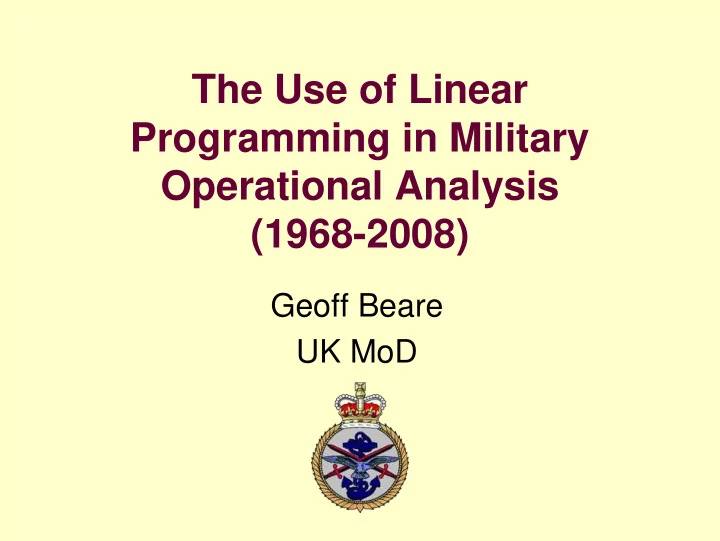

The Use of Linear Programming in Military Operational Analysis (1968-2008) Geoff Beare UK MoD
Logistic Modelling (1968-9) • Assess whether the logistic transport in support of 1BR Corps was sufficient to sustain combat elements in general war on the NATO central front. • LP benefits: – the model could be formulated in a few days and fed into a standard package. – the model would be capable of exploring the whole solution space and delivering a consistently good result over a wide range of variations.
Simplified 1(BR) Resupply System R4 R2 R1 R5 R6 R3 R7 Div Bde Arty BG Corps
Objective Function • Each front line unit and resupply point in the system had a starting stock and a required stock level. If the stock fell below this required level a shortfall was logged. • The objective function of the model was to minimise the maximum shortfall across the system (MINIMAX).
Outcome • The model proved to be flexible and fast running • It enabled advice to be given to the logistic managers on the balance of transport between the different resupply regions. • The model was used in a follow-on study that tested the ability of Warsaw Pact forces to sustain the advance rates that were predicted for them.
Reinforcement and Redeployment Modelling (1969-75) • Determine the most economic mix of air and sea transport and pre-positioned forces and equipment to meet worldwide requirements for deployment of forces to prevent or deal with a range of threats. • Determine how reinforcement times could be minimised with existing transport and stockpiles.
Two Problems • The original model had been directly coded in MPS format, with the coefficients calculated by hand, and with no record of those calculations • Need to optimise on time, but since time was a factor in many of the coefficients, to do this directly would result in a severely non-linear formulation that could not be solved
Minimising Reinforcement Times • Varying time potentially makes problem non-linear – Adopt iterative approach using RHS parametrics – Method converges in 2 to 3 iterations • Reinforcement times reduced from 42 days to 23 days
Air Defence Mix Study (1982-3) • Determine the required level of investment in ground-based air defence and the optimum balance between area and point defence systems
FLOT Red Tracks AD Sites
Study Problems • Two issues: – Large number of simulation model runs required – Inability to select consistently good AD system deployments as investment increases • The solution to the problem was to build a simple LP model of the allocation process. – objective to maximise kills against the worst track (MAXIMIN)
Performance Performance/cost plot with manual deployment of AD systems Investment Performance Performance/cost plot with LP-based deployment of AD systems Investment
Benefits of LP Approach • LP achieved consistently effective deployments that provided a more balanced defence against varying combinations of threat tracks • LP saved a great deal of time and effort in running the simulation model
Strategic BoI Study (2007-9) • What is the most cost-effective mix of Force Elements and Force Enablers that will enable the UK to meet the range of operations required by current Defence Policy? – Force elements include maritime and air platforms and land force units at company/squadron level – Force enablers include strategic transport, logistic support, ISTAR and C2
BoI Process Endorsed Planning Scenarios Campaigns Optimum Effects Variations in data Force Pool and assumptions Insights and analysis Optimisation Tasks into outputs Enabler Systems Options Options Concurrency Requirements System Availability Costs
Scope of Strategic BoI LP • The Linear Programme will simultaneously consider: – Force Elements and Enablers - capabilities, readiness and availability – Campaign Requirements by task, including enabling tasks – Time Frames by epoch – Concurrency Requirements – Whole life costs • Generates the least cost force pool that will meet Policy
Conclusions • The combination of simulation and LP offers a very powerful approach • Options can be compared on a consistent basis • LP models can be rapidly formulated and implemented • RHS parametrics allow rapid exploration of the solution space • A MAXIMIN or MINIMAX objective function provides solutions that are robust to uncertainty • Potentially non-linear problems can be solved by using an LP formulation iteratively
Questions?
Recommend
More recommend